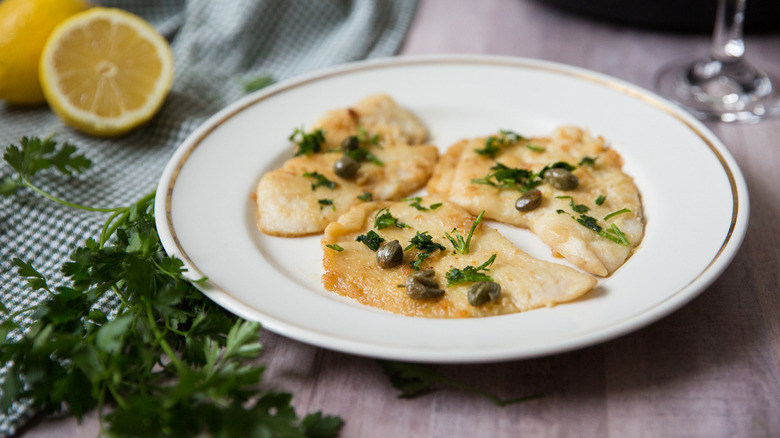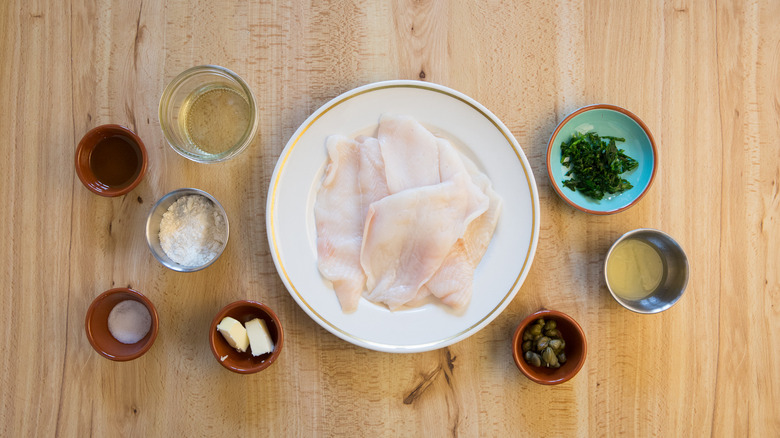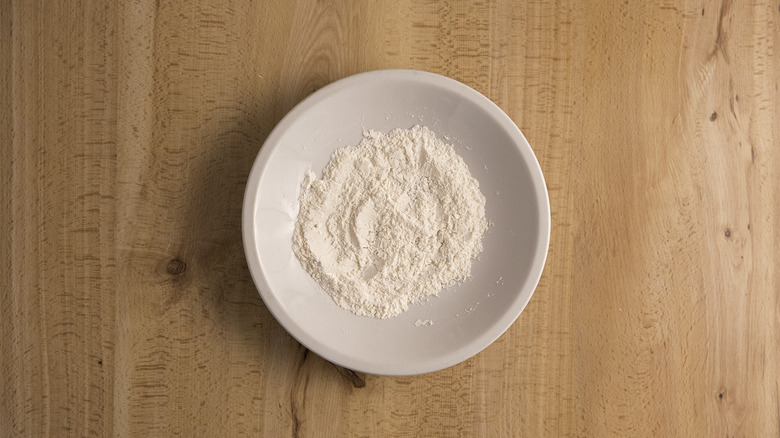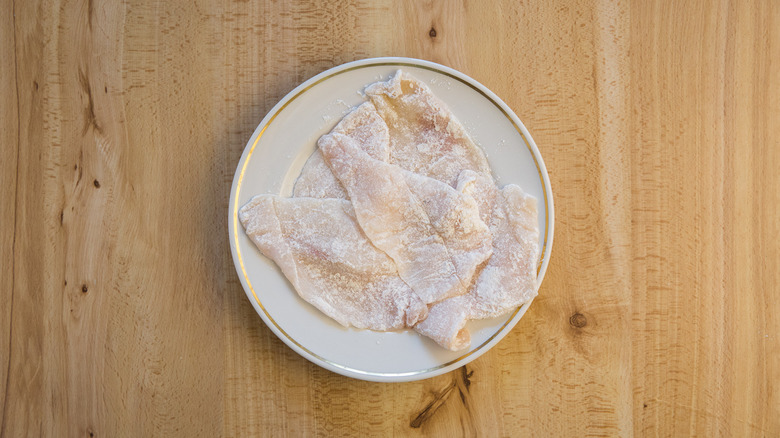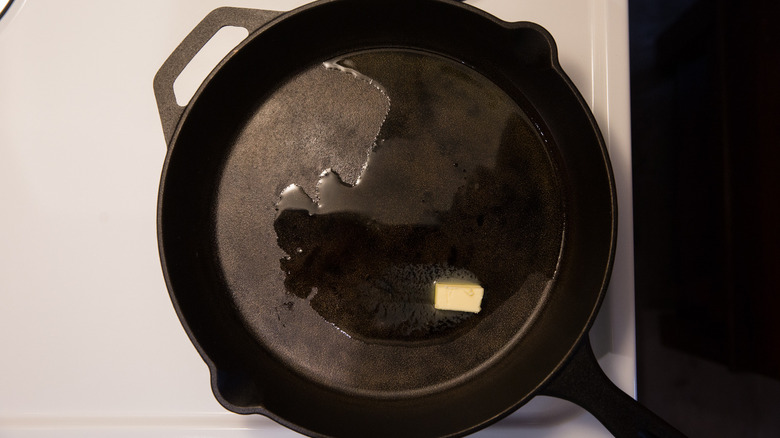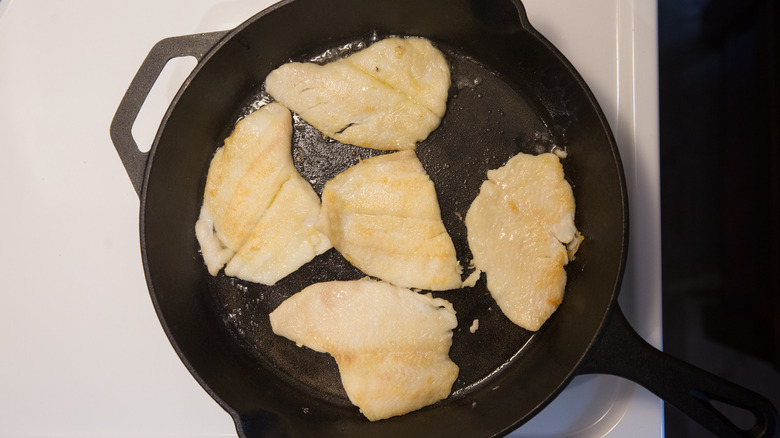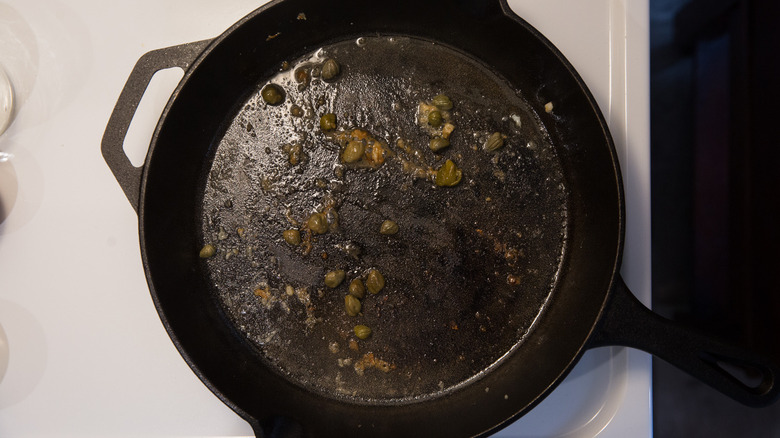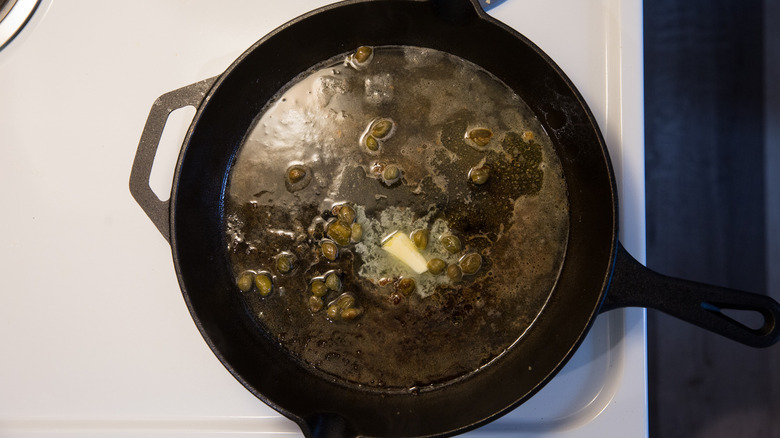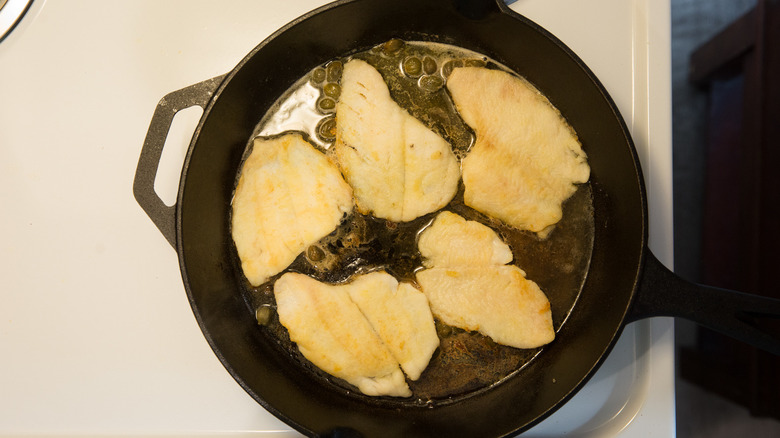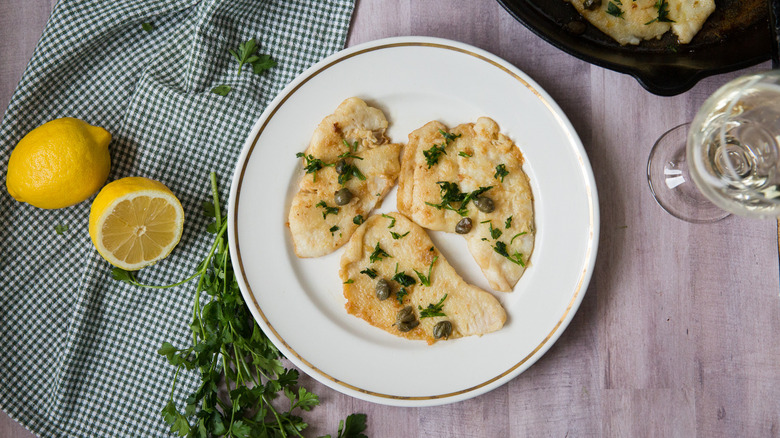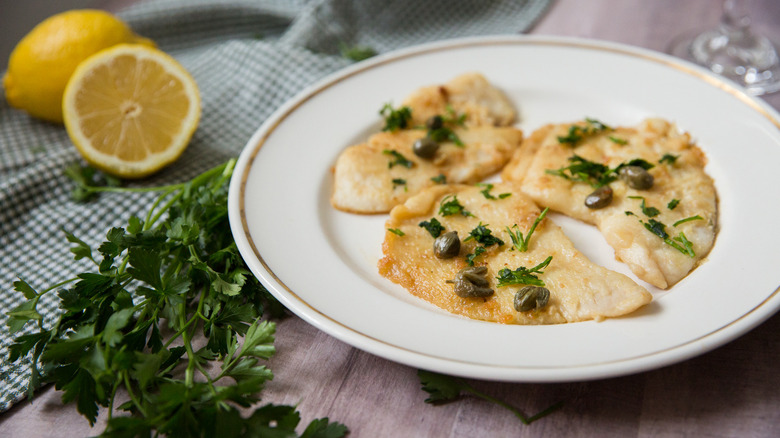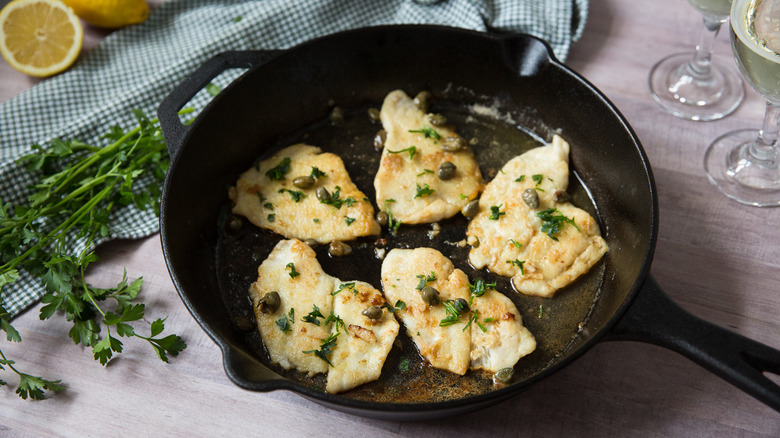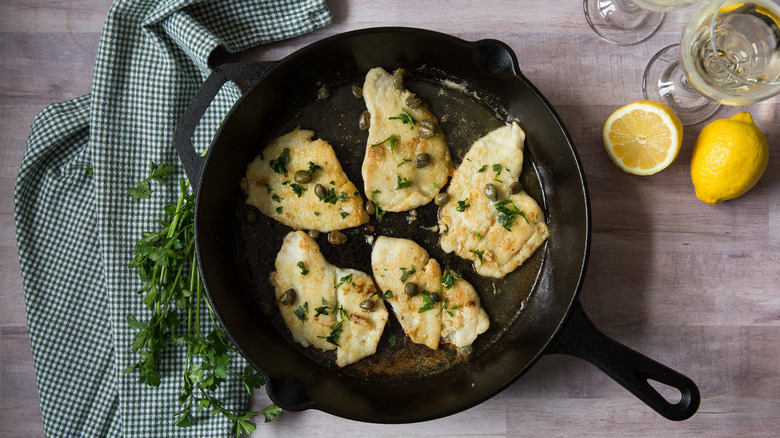Bright, Delicate Flounder Piccata Recipe
Piccata dishes, like the ever-popular and easy chicken piccata, are so rich and delicious that they may seem complicated to prepare. In reality, they come together in less than half an hour and can even be made on weeknights. Made popular in the United States by Italian-American immigrants, piccata refers to thin pieces of meat that are dredged in flour and pan-fried before being cooked in a lemon-butter sauce. While chicken and veal piccata are popular on Italian-American restaurant menus, there's another great way to enjoy this dish: with fish.
Recipe developer Michelle Bottalico has created a flounder piccata recipe that's just as simple, crispy, and full of bright flavors as the meaty varieties. The lightly floured flounder fillets are tasty on their own, but they get even better thanks to a creamy, tangy, and herby pan sauce made from butter, white wine, lemon juice, capers, and parsley. If you're new to piccata recipes or have only tried the classics like chicken or veal, add this flounder variation to your repertoire to impress guests with minimal effort.
Gather your bright, delicate flounder piccata ingredients
For this recipe, you will need flounder fillets, as well as all-purpose flour and salt for coating them and both olive oil and unsalted butter for cooking. The piccata sauce also calls for butter and comes together with dry white wine, lemon juice, and drained capers (we recommend rinsing your capers before cooking with them). Finally, you'll use fresh parsley for topping the cooked flounder.
Step 1: Combine the flour and salt
Combine flour and ¼ teaspoon salt in a shallow bowl.
Step 2: Dredge the flounder
Dredge flounder fillets in the seasoned flour until well coated on both sides, shaking off any excess flour.
Step 3: Heat the oil and butter
Add olive oil and ½ tablespoon butter to a large skillet over medium-high heat.
Step 4: Cook the fish
Once oil is hot, add flounder fillets to the pan and cook for 3-4 minutes per side, until golden. (Depending on the size of your pan, you may need to do this in batches.) Transfer fish to a plate and set aside.
Step 5: Start cooking the sauce
Reduce heat to medium and add wine, lemon juice, capers, and remaining ⅛ teaspoon salt to the same pan. Cook for about 2 minutes.
Step 6: Stir in the butter
Stir in the remaining ½ tablespoon butter until melted.
Step 7: Cook the fish in the sauce
Return flounder fillets to the pan and let cook in the sauce for 2 more minutes, turning halfway through.
Step 8: Plate the fish
Plate flounder, drizzle on the remaining pan sauce, and top with parsley.
Step 9: Serve the flounder piccata
Serve immediately.
What does piccata mean?
Piccata is an Italian word that comes from the French word piqué, which roughly means "to prick," and it refers to the act of pricking meat with a fork or pounding it flat to help tenderize it before cooking. Piccata dishes can be made from veal, chicken, or other ingredients such as fish, and what all these proteins have in common is that they are flat in shape. Flounder fillets are already flat, while chicken breasts are typically sliced thin and pounded flat before being prepared piccata-style. The origins of piccata dishes aren't clear, but they are popular Italian-American dishes that may have been brought to the U.S. by Italian immigrants or invented once they arrived.
Piccata is similar to scaloppini (spelled scaloppine in Italian), but the difference between piccata and scallopini is that scallopini refers to the thinness of the meat, which can be dressed with different kinds of sauce. Piccata, on the other hand, refers to a specific kind of sauce that is usually made with butter, white wine, lemon juice, parsley, and sometimes capers.
What kinds of fish can you use for piccata dishes?
You have many options when choosing a protein to make piccata-style. In Italy, veal is the most popular choice. In the U.S., chicken is king, with fish and veal piccata recipes appearing as well. If you're a vegetarian, you can also turn piccata into a vegetable dish, such as with thinly sliced zucchini or eggplant for a Mediterranean feel or roasted winter vegetables or cremini mushrooms for a heartier version. Whatever protein you use, piccata dishes are all prepared in the same way, so you can use the technique in this recipe for your main ingredient of choice.
If you're looking for a different kind of fish to substitute for flounder in this recipe, you can use any other flat white fish like sole, halibut, or plaice. While the presentation will be a bit different, heartier kinds of fish like salmon or cod would make a tasty piccata dish as well; just make sure to adjust the frying time according to the thickness of the fillets.
Bright, Delicate Flounder Piccata Recipe
While this piccata recipe would also work for chicken or veal, using flounder makes the bright and lemony dish extra light for a simple weeknight meal.
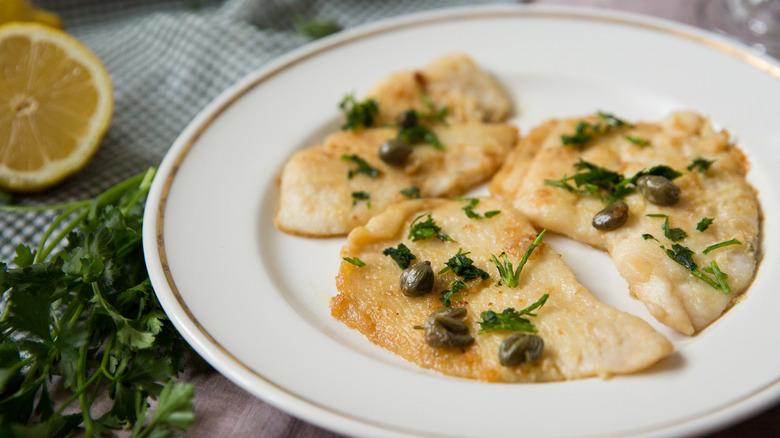
Ingredients
- 2 tablespoons all-purpose flour
- ¼ teaspoon + ⅛ teaspoon salt, divided
- ½ pound flounder fillets
- 1 tablespoon olive oil
- 1 tablespoon unsalted butter, divided
- 4 tablespoons dry white wine
- 1 tablespoon lemon juice
- 1-2 tablespoons capers, drained
- 1 tablespoon minced fresh parsley
Directions
- Combine flour and ¼ teaspoon salt in a shallow bowl.
- Dredge flounder fillets in the seasoned flour until well coated on both sides, shaking off any excess flour.
- Add olive oil and ½ tablespoon butter to a large skillet over medium-high heat.
- Once oil is hot, add flounder fillets to the pan and cook for 3-4 minutes per side, until golden. (Depending on the size of your pan, you may need to do this in batches.) Transfer fish to a plate and set aside.
- Reduce heat to medium and add wine, lemon juice, capers, and remaining ⅛ teaspoon salt to the same pan. Cook for about 2 minutes.
- Stir in the remaining ½ tablespoon butter until melted.
- Return flounder fillets to the pan and let cook in the sauce for 2 more minutes, turning halfway through.
- Plate flounder, drizzle on the remaining pan sauce, and top with parsley.
- Serve immediately.
Nutrition
| Calories per Serving | 246 |
| Total Fat | 14.9 g |
| Saturated Fat | 5.0 g |
| Trans Fat | 0.0 g |
| Cholesterol | 66.3 mg |
| Total Carbohydrates | 7.7 g |
| Dietary Fiber | 0.5 g |
| Total Sugars | 0.5 g |
| Sodium | 490.9 mg |
| Protein | 15.2 g |
